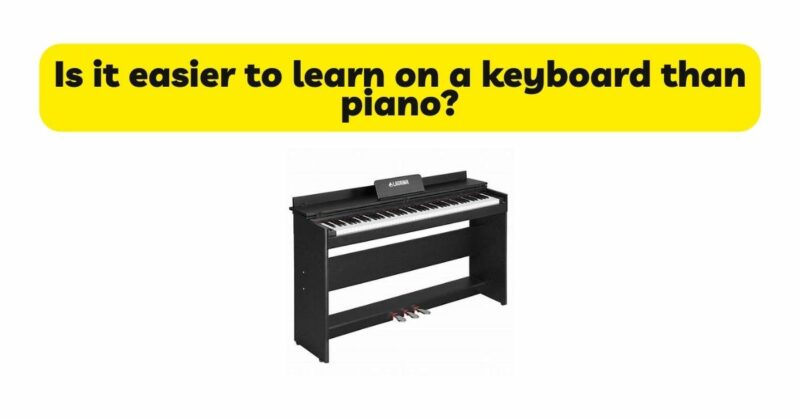Learning to play an instrument, such as the piano, is a fulfilling and rewarding endeavor. When considering whether it is easier to learn on a keyboard or a piano, various factors come into play. In this article, we will explore the advantages and considerations of learning on a keyboard versus a piano, shedding light on the potential ease of learning associated with each instrument. While individual preferences and circumstances may influence the learning experience, understanding the characteristics of each instrument can help aspiring musicians make an informed decision.
- Accessibility and Convenience: One aspect that makes learning on a keyboard potentially easier is its accessibility and convenience. Keyboards are typically lightweight, portable, and compact, making them easy to transport and store. This convenience allows learners to practice anytime and anywhere, without being restricted by space or the need for a dedicated practice area. In contrast, pianos, especially acoustic pianos, are larger and heavier, requiring a dedicated space and sometimes professional assistance for relocation. The accessibility and convenience of keyboards can contribute to regular practice and a more flexible learning schedule.
- Affordability and Availability: Financial considerations play a significant role in the decision-making process. Keyboards are generally more affordable compared to pianos, particularly acoustic pianos. Entry-level keyboards offer a range of features and functionalities at a fraction of the cost of a traditional piano, making them accessible to a wider range of learners. Additionally, keyboards are widely available, both in physical stores and online, making them easily accessible for beginners. In contrast, pianos, especially high-quality acoustic pianos, can be expensive and may require additional investment in maintenance and tuning.
- Technological Advancements: The advancement of technology in keyboards can contribute to the ease of learning. Many keyboards now feature built-in tutorials, learning modes, and interactive lessons designed specifically for beginners. These learning tools can provide step-by-step guidance, finger placement assistance, and visual feedback, helping learners progress at their own pace. Additionally, keyboards often have features such as metronomes and recording capabilities that aid in practice and self-evaluation. While pianos lack these built-in learning tools, learners can still access online tutorials and educational resources to support their learning journey.
- Sound Options and Experimentation: Keyboards offer a wide range of sound options and built-in features, which can contribute to a more engaging and versatile learning experience. They often include various instrument sounds, such as piano, strings, organs, and synthesizers, allowing learners to explore different musical styles and genres. This versatility can provide motivation and inspiration, particularly for beginners who may find experimenting with different sounds exciting. In contrast, acoustic pianos produce a single sound, limiting the range of sound experimentation available during the learning process.
- Touch Sensitivity and Expression: One aspect in which acoustic pianos may have an advantage is in touch sensitivity and expression. Acoustic pianos have mechanical action, where the touch of the keys directly influences the sound produced. This touch sensitivity is crucial for developing proper technique, dynamics, and expressive playing. While keyboards may have weighted keys and attempt to replicate the touch of an acoustic piano, the nuances of touch response may not be fully captured. However, it is worth noting that high-end digital pianos often offer more advanced key action, providing a closer approximation to the touch sensitivity of an acoustic piano.
- Transitioning to Different Pianos: If the goal is to transition to playing different types of pianos, such as upright or grand pianos, starting on an acoustic piano may provide a smoother learning curve. Acoustic pianos require certain adjustments in technique due to their mechanical action and the nuances of different piano types. However, with proper guidance and focused practice, learners who begin on a keyboard can still adapt their skills to different pianos. It is important to note that the fundamental skills developed, such as note reading, hand coordination, and music theory, can be transferred between instruments.
Conclusion: Determining whether it is easier to learn on a keyboard or a piano depends on several factors, including personal preferences, financial considerations, and learning goals. Keyboards offer accessibility, affordability, and technological advantages that can contribute to an easier learning experience, particularly for beginners. The versatility of sound options and built-in learning tools in keyboards can enhance motivation and engagement. However, acoustic pianos provide touch sensitivity, expression, and authenticity that may be important for certain learners and musical aspirations. Regardless of the instrument chosen, consistent practice, dedication, and guidance from a knowledgeable teacher remain essential for progress and skill development. Ultimately, it is the passion for music and commitment to learning that will lead to successful piano playing, regardless of the instrument chosen.


